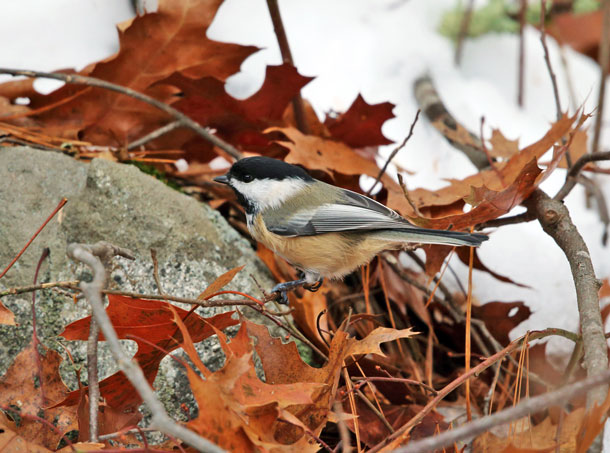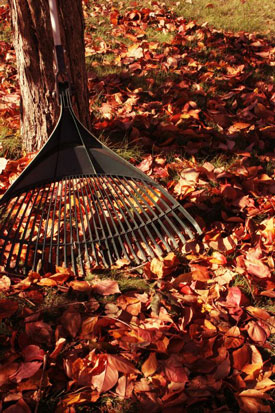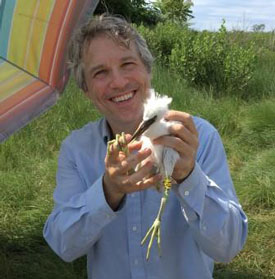Let The Leaves Be And Feed The Birds
Air Date: Week of November 8, 2019

Many birds, like the Black-Capped Chickadee, rummage through the leaf litter in fall and winter in search of the seeds and bugs that may be hiding underneath. (Photo: Tom Murray; Flickr CC)
Autumn brings fallen leaves in temperate zones, and the chore of raking all those leaves into piles. But it turns out that a lazy fall yard-work ethic can help native birds. Tod Winston of the New York Audubon Society explains to Host Steve Curwood why leaving fallen leaves and dead flowers helps insects that are food for birds.
Transcript
CURWOOD: A lazy fall yard-work ethic can actually be big help for native birds. And the Audubon Society has tips on how to use leaf litter to create helpful spaces for birds in your own back yard. Tod Winston is a Birding Guide and Research Assistant for the New York City Audubon Society, and joins me now. Welcome to living on earth.
WINSTON: Thank you so much, happy to be here.
CURWOOD: So tell me, why would keeping a messy fall yard be a benefit for birds?
WINSTON: Well, you know, in so many areas where people live, an aesthetic has taken over, over the past decades that is something like a pristine English estate, you know of lawn, and house, and not much more, a few ornamental shrubs. And that habitat is something that people feel comfortable with. But it's really not a habitat that's made for birds and wildlife. And something approximating more of a wild habitat can provide a much richer habitat for the wildlife and birds that so many of us love.
CURWOOD: Wait a second, though, I mean, this is such a wonderful thing to do in the fall, you get the family together, you all get out there raking and you do pruning and everything looks all neat and tidy afterwards. And it's a whole ritual.
WINSTON: So, I'm remembering lovely times, raking the leaves, I guess that you remember the good parts of it, it wasn't all lovely. But I remember raking the leaves with my father and grandfather, that was something we all did in the fall, it was something that was expected of us. But I guess what I would recommend though, is leave a space that is a happy place for birds and wildlife to spend the winter and you know, that's something that will reap benefits throughout the entire year, not just the wintertime.
CURWOOD: So Todd, what can you do to keep up what you call a messy yard?

It may be customary to rake leaves in the fall, but taking a break from the yard work may help the wildlife in your backyard by providing them food and shelter. (Photo: Jessica Quinn; Flickr CC)
WINSTON: So, you know, there are a number of things to think about, and one is certainly to leave the leaves on your property or rearrange them at least, so that they can provide a nice leafy rich understory for critters to overwinter in. Another is to, in a flower garden, leave the flower heads of beautiful flowers like sunflowers, black-eyed susans, cone flowers, those seed heads provided millions of seeds that last through the winter, and provide a smorgasbord for birds to feast on all winter long. Another way to provide a great habitat for birds is to create a brush pile of fallen branches or pruned branches. And you can do that by building a brush pile with larger branches underneath and smaller branches above; that creates an amazing shelter for all sorts of critters, including birds. And related to those dead branches is to leave dead branches where they fall and leave, if you can, snags or dead trees standing, which are great habitat for woodpeckers. Woodpeckers will excavate holes that, then, all sorts of birds like chickadees, and titmice, nuthatches will also nest in. So you know many of us in our desire to clean up our woods remove dead trees and those dead trees are really important for birds.
CURWOOD: Of course under leaves, one finds worms, right?
WINSTON: Right. So there are all sorts of critters that live under leaves, and some are good for birds, worms, and particularly moth pupae, you know, you see moths and butterflies and you don't often think about, a lot of us, I think, that all moths and butterflies are in cocoons, like a monarch butterfly on a plant. But actually, the vast majority of moth pupae are in the ground. Those moths, that caterpillars that are munching on leaves when they're ready to metamorphose they dropped to the ground. And so on a property without a rich ground habitat of leaves, those moths have nowhere to create their pupae and create a new generation of moths. And, come springtime many birds, forest birds depend on all the critters that live in the leaf litter - beetles, moth pupae, worms. As well, many creatures that are beneficial to the garden - praying mantises, lace wings, ladybugs, they all over winter in that leaf litter. So if you - you're actually doing your garden a service by leaving that leaf letter and providing habitat for critters that are beneficial to the garden.
CURWOOD: Tod, you must have some tips for folks who are really avid bird fans.
WINSTON: You know, a lot of folks who first get into birding are shocked when they just start to listen and open their eyes to see what lands in their, as birders say, patch. And that means just see what shows up where you live. An important thing to think about look to see what's growing there. You may have native plants that are really important for birds that are right there and you don't have to buy them, all you have to do is give them a chance to thrive in your yard.
CURWOOD: So, what specific varieties of plants do you recommend to encourage visitation from our feathered friends where I am, we have actually an invasive species an autumn olive that well the bird seem to like that.
WINSTON: Well, you know, like people like potato chips and Cheetos, birds like shrubs like the autumn olive. Autumn olive berries are kind of tasty, I kind of like them myself, but that really is part of the problem with non-native shrubs that have been planted and have escaped and spread all over the United States. Plants like autumn olive, multiflora rose, bitter sweet, Japanese honeysuckle, the list goes on and on. Those are plants, all of which have tasty berries that birds like, and birds eat those berries and then spread the seeds all over the place. But when it comes to the spring time, and birds need bugs to feed their babies, those non native plants don't have, host a rich insect life and do not provide the protein that, via insects, that birds need to feed their babies. That's really the problem. So when we're thinking about what to plant in our yards we should be thinking about what birds need all year round. There are many kinds of shrubs, service berry, and trees, black cherry, that are native to where we live, at least here in the in the northeast. And there are varieties and of those plants across the United States that can be great for birds.

Tod Winston is a Research Associate with the NYC Audubon Society. (Photo: NYC Audubon Society)
CURWOOD: Tod, you live in New York City. Where do you live, a place where you have control over your yard?
WINSTON: I live in an apartment on the third floor of a little apartment building. But you know, even people who live in urban settings can put some native plants on their balcony or on their patio. And those plants could be useful both to breeding birds and to migratory birds that pass through the city.
CURWOOD: By the way, talk to me about the history of yard work. Why do people rake up the leaves in their yards to begin with?
WINSTON: You know, I honestly don't understand that, people are obsessed with being neat and tidy. You know. And that is a basic part of it, that people are afraid of the disorder, afraid of what's lurking in those leaves. And, you know, part of this effort to get people to connect to the nature in their backyards, to have positive impact for the nature in their backyards, is to connect them to what lives in that leaf litter. They're all sorts of fascinating creatures and beautiful creatures that depend on messiness, that depend on native plants. And, you know, just like new birdwatchers, people who are new to really observing what's in their gardens can be amazed by the variety of life that live there.
CURWOOD: Tod Winston, birding guide and research assistant for New York City's Audubon. Tod, thanks for taking the time with us today.
WINSTON: Thank you so much for having me on. It's been a pleasure.
Links
Living on Earth wants to hear from you!
Living on Earth
62 Calef Highway, Suite 212
Lee, NH 03861
Telephone: 617-287-4121
E-mail: comments@loe.org
Newsletter [Click here]
Donate to Living on Earth!
Living on Earth is an independent media program and relies entirely on contributions from listeners and institutions supporting public service. Please donate now to preserve an independent environmental voice.
NewsletterLiving on Earth offers a weekly delivery of the show's rundown to your mailbox. Sign up for our newsletter today!
 Sailors For The Sea: Be the change you want to sea.
Sailors For The Sea: Be the change you want to sea.
 The Grantham Foundation for the Protection of the Environment: Committed to protecting and improving the health of the global environment.
The Grantham Foundation for the Protection of the Environment: Committed to protecting and improving the health of the global environment.
 Contribute to Living on Earth and receive, as our gift to you, an archival print of one of Mark Seth Lender's extraordinary wildlife photographs. Follow the link to see Mark's current collection of photographs.
Contribute to Living on Earth and receive, as our gift to you, an archival print of one of Mark Seth Lender's extraordinary wildlife photographs. Follow the link to see Mark's current collection of photographs.
 Buy a signed copy of Mark Seth Lender's book Smeagull the Seagull & support Living on Earth
Buy a signed copy of Mark Seth Lender's book Smeagull the Seagull & support Living on Earth

